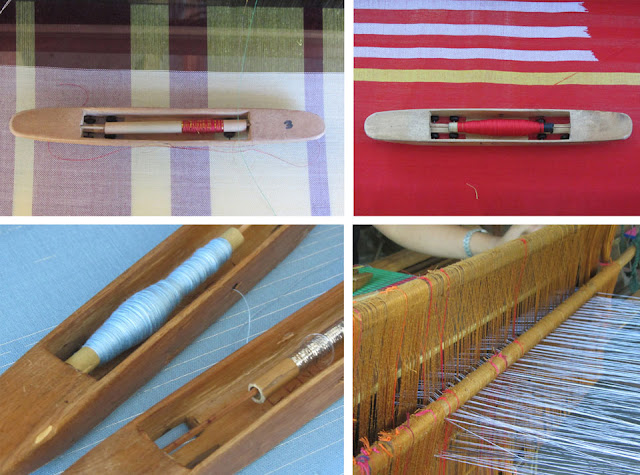Maya Fashion
Hand woven textiles in the Philippines were popular in the 1950’s. But at the onset of the 1980’s when machine-woven cloths are more sought after, the traditional art of weaving gradually declined.
But, before it could experience demise, lifestyle and fashion designers and entrepreneurs came to the rescue. After all, they found that these hand woven textiles can be fused with modern materials and in the process, save the livelihood of old folks.
Supporters of this no-longer-dying industry continue to sprout. One of them is Maya, a new fashion house that provides clothing and accessories to the public by using a combination of new and traditional raw materials.
“Maya patronizes the traditionally hand woven cloth by women from various villages and community groups in South Cotabato, Sarangani, Marawi, Bicol, Benguet, Mountain Province and Aklan,” according to Joyce Jardeleza, one of the personalities behind Iloilo-based Maya.
“Our designer is Marvin Banaag of the Young Designers Guild of Iloilo,” she said, adding that the people behind the brand are avid young entrepreneurs who are into trade of sustainable products, who support and promote everything that are Filipino-made.
“ We greatly support local talents and skills that have produced world-class and noteworthy products such as the traditional piña, jusi barong and terno, and other local raw materials that are rich in patterns, colors, artistic designs and with great craftsmanship. Everything about these hand woven materials speak and reflect the cultures of the Filipino weavers. Importantly, these are great fabrics made in the best materials from the Philippines,” Jardeleza explained.
Some of the cloths that Maya uses are abaca, piña, sinamay, t’nalak and Muslim and Ifugao cloth.
“The weavers toil from gathering the threads which are organically grown and produced in their community, to dyeing them in different colors and plotting them in an ancient hand-weaving machine,” Jardeleza explained.
Closest to home is Aklan, the oldest and biggest source of piña cloth. It is made from the leaves of the pineapple, thus the Spanish name piña. Weavers painstakingly separate the fiber from the leaf. One by one, the fibers are scraped and knotted to form a long filament. This is then woven, resulting to the piña cloth.
Meanwhile, abaca, sinamay and t’nalak are derived from a musa textilis, a native banana plant in the country. After harvest, the leaves of this plant are either separated into a variety of sheaths (the process is called tuxying) or stripped in order to get the fibers. Then, the fiber is pulped and turned into a clothing material. T’nalak, famous for its exotic design, is made by weavers from South Cotabato.
Jardeleza said that Maya will also tap Ilonggo weavers like those in the famous towns of Miag-ao and Oton, sources of the famous ‘hablon’. Hablon refers to any hand woven textile like jusi, piña, cotton and rayon.
“We intend to tap all the hand weavers all over the country to showcase all the talents of the Filipino, especially the women. We actually started from Mindanao, then we are reaching out to the weavers in the Visayas, and then, Luzon,” Jardeleza said.
Through the utilization of these indigenous materials, the local weavers are given a stable source of livelihood. They now have a means to feed their families and achieve their dreams.
GLOBAL MARKET
Apart from being empowered, the weavers are also given a chance to showcase their works in the global scene.
“We also wanted to show the versatility of these raw materials and incorporate them with classic and modern clothing designs to intercept both local and global market tastes,” said Jardeleza.
She explained that this also promotes Philippine tourism because the weavers come from different indigenous cultures in the country. “We believe this is one good way of empowering women and promoting their culture,” she said.
So, who says that tradition has to die? Through entrepreneurs who put local products at the forefront of their business decisions, traditions indeed, can survive modernity.* (The News Today, http://www.iloilonewstoday.com/, November 3, 2011)
But, before it could experience demise, lifestyle and fashion designers and entrepreneurs came to the rescue. After all, they found that these hand woven textiles can be fused with modern materials and in the process, save the livelihood of old folks.
Supporters of this no-longer-dying industry continue to sprout. One of them is Maya, a new fashion house that provides clothing and accessories to the public by using a combination of new and traditional raw materials.
“Maya patronizes the traditionally hand woven cloth by women from various villages and community groups in South Cotabato, Sarangani, Marawi, Bicol, Benguet, Mountain Province and Aklan,” according to Joyce Jardeleza, one of the personalities behind Iloilo-based Maya.
“Our designer is Marvin Banaag of the Young Designers Guild of Iloilo,” she said, adding that the people behind the brand are avid young entrepreneurs who are into trade of sustainable products, who support and promote everything that are Filipino-made.
“ We greatly support local talents and skills that have produced world-class and noteworthy products such as the traditional piña, jusi barong and terno, and other local raw materials that are rich in patterns, colors, artistic designs and with great craftsmanship. Everything about these hand woven materials speak and reflect the cultures of the Filipino weavers. Importantly, these are great fabrics made in the best materials from the Philippines,” Jardeleza explained.
Some of the cloths that Maya uses are abaca, piña, sinamay, t’nalak and Muslim and Ifugao cloth.
“The weavers toil from gathering the threads which are organically grown and produced in their community, to dyeing them in different colors and plotting them in an ancient hand-weaving machine,” Jardeleza explained.
Closest to home is Aklan, the oldest and biggest source of piña cloth. It is made from the leaves of the pineapple, thus the Spanish name piña. Weavers painstakingly separate the fiber from the leaf. One by one, the fibers are scraped and knotted to form a long filament. This is then woven, resulting to the piña cloth.
Meanwhile, abaca, sinamay and t’nalak are derived from a musa textilis, a native banana plant in the country. After harvest, the leaves of this plant are either separated into a variety of sheaths (the process is called tuxying) or stripped in order to get the fibers. Then, the fiber is pulped and turned into a clothing material. T’nalak, famous for its exotic design, is made by weavers from South Cotabato.
Jardeleza said that Maya will also tap Ilonggo weavers like those in the famous towns of Miag-ao and Oton, sources of the famous ‘hablon’. Hablon refers to any hand woven textile like jusi, piña, cotton and rayon.
“We intend to tap all the hand weavers all over the country to showcase all the talents of the Filipino, especially the women. We actually started from Mindanao, then we are reaching out to the weavers in the Visayas, and then, Luzon,” Jardeleza said.
Through the utilization of these indigenous materials, the local weavers are given a stable source of livelihood. They now have a means to feed their families and achieve their dreams.
GLOBAL MARKET
Apart from being empowered, the weavers are also given a chance to showcase their works in the global scene.
“We also wanted to show the versatility of these raw materials and incorporate them with classic and modern clothing designs to intercept both local and global market tastes,” said Jardeleza.
She explained that this also promotes Philippine tourism because the weavers come from different indigenous cultures in the country. “We believe this is one good way of empowering women and promoting their culture,” she said.
So, who says that tradition has to die? Through entrepreneurs who put local products at the forefront of their business decisions, traditions indeed, can survive modernity.* (The News Today, http://www.iloilonewstoday.com/, November 3, 2011)





